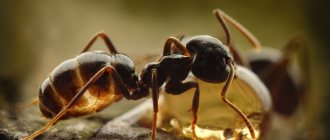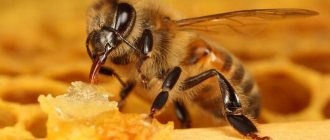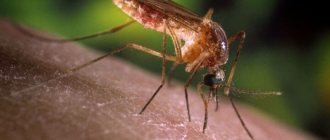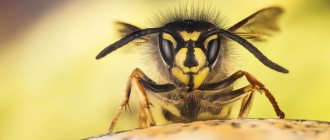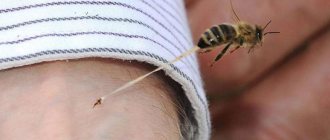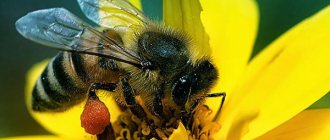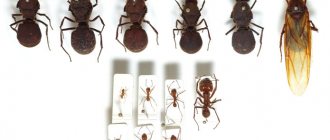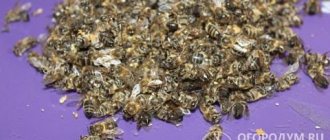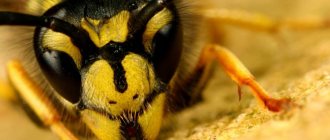A bee is a flying insect whose closest relatives are ants and wasps. Despite the fact that everyone has known it well since childhood, it is unlikely that anyone will be able to immediately answer how many legs a bee has or what its flight speed is.
Speaking about how much it weighs, it must be emphasized that its weight depends on what functions will be performed. On average, weight can range from 85 mg to 280 mg. As you can see, the scatter is quite large and also depends on the region of residence. This is the reason why sometimes they appear very small and sometimes they appear large.
General characteristics of a bee
In total, there are about 21 thousand species and 520 genera of bees. They are found on 6 continents. Nature created them so that they are able to feed on nectar and pollen, making them the main pollinators of flower plants. Bees draw in nectar, which is a source of energy, with the help of a long proboscis, and find it and pollen thanks to their antennae. This is their main sense of smell. All individuals of the bee family have one pair of antennae. They consist of segments, the number of which depends on the sex of the individual.
Bees necessarily have two pairs of wings, one pair of which (front) is larger than the second (back). Everyone knows what color a bee is: black with yellow transverse stripes, but the body length varies, depending on the species, from 2.1–39 mm. The smallest size are dwarf bees, the largest are representatives of the species Megachile pluto, living in Indonesia. The bee development cycle has the following stages: egg, larva, pupa, and adult. The egg is laid in a cell.
The type of newborn individual (queen, drone, worker) depends on which part of the queen cell the egg is placed in. The egg laid by the queen is located vertically in the cell. When fertilization occurs, the embryo begins to develop, the position of the egg in the cell will change (it will gradually tilt to the side). After 68–76 hours, required for the development of all organs of the embryo, the egg will lie horizontally at the bottom of the cell.
At this point, the bees place food next to the egg, which will contribute to the destruction of the egg shell and the emergence of a tiny larval worm from it. The bees constantly add food, so the larva is surrounded by food, which is constantly mixed due to the movements of the worm. The hatched larva is only 1.6 mm long and transparent. By the end of the first day of its life, it already reaches 2.6 mm and its body becomes less transparent.
Important! After sealing, the larva of the future worker bee loses weight, while the future queen, on the contrary, gains weight. Because of this, nurse bees gnaw off the lid in advance and nibble the queen’s cocoon to make it easier to leave it.
On the third day of life, the larva will fill the entire bottom of the cell and have a matte color. From this moment on, different larvae begin to be fed differently. Thus, the diet of worker bees from the first day of life consists of milk, then it is replaced with honey and beebread. Future queens are fed exclusively with milk. Drones are also fed milk, but it is even more satisfying. Over the course of 5 (queen), 6 (worker) and 7 (drone) days, the larva molts 4 times. At the end of the last day, nurse bees seal the cells with larvae.
The pupation process begins. How many days this will take also depends on the type of larva. Until the pupa has turned into an adult insect, the molting process occurs a couple more times and after the last shedding of the old shell, the young insect gnaws through the lid and crawls out. In total, it takes 20 days to develop for a worker bee, 16 for a queen bee, and 24 for a drone.
Life cycle features
Due to the distribution of roles in the hive, each caste has a different purpose in the life cycle of a new honey bee. So, the uterus serves for reproduction. Apart from her, no one will lay eggs, therefore a hive cannot exist without this caste. The queen leaves the hive only in one case: when swarming occurs, she flies with the new family to look for a new home.
Workers care for the larvae, which emerge as the next stage of development of the young honey bee. They develop 3 days after the eggs are laid. The larvae cannot survive on their own, so worker bees feed them all the time while they are developing. After 6 days, the larvae are sealed in honeycombs with wax until pupation. They spend 12 days in such boxes. Already young individuals (imago) crawl out of there on their own - no one can help them with this. The imago has a more tender body and does not sting. The purpose of her presence in the hive is to clean the hive and maintain it in working order.
| Formation stage | Uterus | Working bee | Drone |
| duration in days | |||
| Egg | 3 | 3 | 3 |
| Larva | 5 | 6 | 7 |
| Doll | 8 | 12 | 14 |
| Total: | 16 | 21 | 24 |
If the eggs are not fertilized, they develop into a drone. These are large insects that lack the ability to collect and process pollen and have no sting. The duties of drones include fertilizing the uterus. This is where the real race begins, since there are many individuals capable of this and not all can fertilize it. For failure to fulfill their duties, extra drones are kicked out of the family. Apart from fertilization, the drone has no other functions. And the protection, arrangement, and construction of the hive is the prerogative of the worker bee, where representatives of other castes do not interfere.
The life period of new honey bees closes at different times: if the queen lives for 7 years, then the worker honey bee dies by the end of the 8th week of life. Drones have an even shorter cycle - 5 weeks. During this time, a new generation manages to grow up, sometimes in larger numbers than necessary. In this case, the production of honey and the construction of honeycombs stop: the family begins to divide into two, which is not at all desirable for the beekeeper, since half of the family will fly away. By reducing the amount of honey, it is possible to determine that there is a danger of swarming and an experienced owner can prevent it.
| Life period | |
| Uterus | 7 years |
| Working honey bee | 8 weeks |
| Drone | 5 weeks |
External structure
The bee's body is segmented. It has the following parts: head, thoracic region, abdomen. The entire body is covered with hairs, which are the organ of touch. In addition, they protect the upper cover of the body from pollution.
What the body consists of can be seen in the figure:
Head
The head is protected by a thick layer of chitin, under which is the brain. Its size depends on the type of bee. In the drone it is larger than in other individuals. The size and shape of the head also depend on the work responsibilities of the insect. The uterus is round, the eyes are shifted to the frontal part. In workers it is triangular, the usual eyes are located on the crown, in drones it is round, and the compound eyes go around the head and converge on the crown. Simple ones are shifted towards the forehead.
Schematic illustration of the head of a bee (head of the queen (A), worker bee (B) and drone (C): 1 - simple eyes, 2 - compound eyes, 3 - antennae, a - main segment, b - flagellum, 4 - upper lip, 5 - upper jaw, 6 - proboscis):
In the wide part of the head on the sides there are 2 large fixed compound eyes. Between them, at the top, there are 3 ordinary eyes. The space between them is dotted with long and thick hairs. In the rest of the head they are shorter. In front, above the upper lip, there are antennae. In females they are divided into 11 segments, in males - into 12.
All of them are connected by membranes, which makes the mustache very mobile. In the cavity of each antennae there is a nerve that goes to the olfactory lobe of the brain. The outer shell of the antennae is an organ of touch and smell. Below is a proboscis, consisting of two lower jaws and a lower lip, capable of closing and dismembering.
Did you know? Bee movement speed
-
about 65 km/h.
If it flies loaded, then this value will decrease to 20 -
30 km/h.
As they move, the trunk takes the shape of a tube, with the help of which the insect collects liquid food. The tongue licks solid food. Only worker bees have such a functional proboscis. In others it is shorter, and the oral apparatus has lost its intended purpose. The upper jaws are well developed because they perform a gnawing function.
With their help, the insect kneads the wax when it builds cells, and when it goes to get food, it removes pollen from the stamens. The lower jaws and lip help lick and suck out nectar. Because of this, the bee’s mouthparts are of the gnawing-sucking type.
Breast
Inside the thoracic region there are muscles responsible for all movements of the insect. It consists of three rings and one abdominal segment. The smallest ring is connected to the head through a thin chitinous film, which allows the latter to make free movements. The middle ring acts as a frame. The front pair of wings is attached to it. The rear pair of wings is attached to the last ring. The total number of wings is 4. Each ring has one pair of legs and spiracles through which air enters the body.
Wing structure
The wings are a thin elastic plate with veins (hardened hollow tubes). When a bee flies, both pairs of wings straighten, forming a single plane, and are fastened together with small hooks. When landing, the hooks are detached and the wings are laid along the body, with the larger front wing covering the rear one. They are driven by the pectoral muscles. In flight, an insect flaps its wings 200–250 times per second.
Important! In honey bees, the front pair of legs is shorter than the others, but more mobile.
Abdomen
Has 6 rings. Each ring is divided into a tergite (dorsal half-rings) and a sternite (abdominal half-rings). They are connected to each other by soft membranes, which allows each part to move freely. This allows the abdomen to grow in width and length if necessary. The main internal organs of the insect are hidden behind the abdomen.
Legs
A bee's legs are multifunctional. They support the body, with their help the bee moves and also cleanses the body. In addition, in working members of the family, the legs help collect pollen and form balls of wax. Each bee has 3 pairs of legs, consisting of 5 segments, connected movably. The front legs have brushes that allow the insect to clean the eyes, mouth and antennae, and also help scrape pollen from the body. The middle legs also take part in removing pollen.
They are covered with a large number of small hairs, which makes it possible to sweep away pollen well. The hind limbs are as well mobile as the forelimbs. On them, on the outside of the shin, there is a basket. In it, the insect forms pollen, which will be transferred to the hive. Only working individuals have such a complex structure of limbs. The rest of the inhabitants of the hive have simpler ones.
Photo gallery
Developmental stages of pupa and larva
Diagram of internal systems
Diagram of the external structure of the body and legs
Scheme of the stinging apparatus
Internal structure
The anatomy of the internal organs of a bee is adapted to their main task - honey production. The internal systems of a bee (sectional side view) are shown in the figure below:
Circulatory system
The bee's circulatory system is not closed, but the blood always circulates in a certain direction. This is achieved thanks to the coordinated work of the heart, aorta, abdominal and dorsal diaphragm. The heart is like a long tube and is located along the back. The chest contains the aorta, which supplies blood to the head. The entire tube is divided into 5 chambers connected through partition valves that allow blood to flow in a certain direction (from the abdomen to the head).
During a minute at rest, the heart pulses 60–70 times. Flight increases the pulsation frequency to 150. The dorsal and abdominal diaphragms are also part of the circulatory system. They control the flow of blood into the body. Blood moves to the limbs, antennae and wings thanks to bubbles located at the base of these parts of the body.
Did you know? When a bee stings, it releases 0.3
–
0.8 mg of poison.
Its quantity will depend on the season and age of the insect. A dose of 0.2 g is lethal to humans. This amount of poison can be obtained from 500 -
1000 sting injections.
Nervous system
It is divided into three sections: central, peripheral and sympathetic. The central one includes the brain and the abdominal chain of nerves, which replaces the spinal cord. The frontal ganglion is the beginning of the sympathetic division, which is responsible for the functioning of the digestive, circulatory and respiratory systems. The brain, as the main hub of the nervous system, contains the bulk of neurons.
The greatest number of them is in the optic lobe and mushroom body. As mentioned earlier, the size of the brain depends on the functions of the bee. In drones it is the largest, but at the same time the worker individual has the most developed sections.
A nerve cell (neuron) is the main structural unit of the nervous system. It has one long process (without branches), transmitting nerve impulses, and a branched process, capable of receiving signals from the unbranched process and other neurons and transmitting it via an electrical signal to its neuron. It turns out that the first process plays the role of an output channel for transmitting information, and the second one plays the role of an input channel.
Respiratory system
The structural features of the insect's respiratory system are such that air enters the body through spiracles, which are holes in the cuticle. Three pairs of spiracles are located on the thoracic region, 6 pairs are on the abdomen. Passing through the spiracles, the air is cleared of dust and collected in bags. This air cannot escape back because the spiracles have valves.
From the bags, air is carried through the trachea through tiny annular branches to all systems of the body. The body leaves the air only through the abdominal spiracles. The large first spiracles are reliably protected by thick hair, but mites can still get into them and cause the development of a disease called acarapidosis.
Important! Usually the old queen leaves the family with the swarm, and the young queen remains in the hive.
Reproductive system
There are two types of females in bees: the queen and the worker, but only the first type is capable of producing high-quality offspring. Usually there is only one queen for the entire bee colony. In working individuals, the genitals are highly reproduced. The ovaries and oviducts do not have developed tubes. They begin to develop under certain conditions (the queen died and the worker bees changed their diet).
This will allow the females to produce eggs, but since they do not have a spermatic receptacle, the eggs will be unfertilized and only males can emerge from them. In the uterus, the ovary has approximately 150 tubes, each containing one mature egg. The ovaries and vagina are connected by a paired oviduct.
The spermatic receptacle is connected to the narrow part of the vagina through a canal. The channel acts as a kind of dispenser, which allows several sperm to pass through at the right moment. If fertilization occurs, a worker will emerge from the egg; if not, a drone will emerge.
In section, the reproductive system of the uterus looks like this (1 - ovary, 2 - paired oviduct, 3 - spermatic receptacle, 4 - accessory gland of the spermatic receptacle, 5 - vagina, 6 - reservoir of the large venom gland, 7 - small venom gland, 8 - sting):
Structure and functions of the sting
The sting is a means of protection, defense of the bee, and also helps in laying eggs. Only females have it. Looking like a needle, the sting is a modified ovipositor. It is located at the end of the abdomen and covered by its outer segments. Three systems of glands are suitable for it: lubricating, small and large poisonous. The surface of the sting itself is similar to a saw, which allows it to get stuck in the tissues of the enemy.
But, unfortunately, because of this the bee loses it and dies. The longer the sting is in the “victim”, the more poison from the reservoir will enter the body and the more harm it will cause. The poison is a colorless liquid with a special aroma and bitter taste. In air it quickly crystallizes.
Important! The productivity of the uterus is highest in the first year of life and slightly less at the beginning of the second. She is capable of laying about 1500 per season.
–
2000 eggs per day.
The structure of the sting is shown in the figure below, where 1 - sled, 2 - processes of the sled, 3 - oblong plate, 4 - palp, 5 - triangular plate, 6 - stylets, 7 - square plate, M1-M4 - sting muscles, B. Zh. .—large poisonous gland, Yar—reservoir of the poisonous gland, M. Zh.—small poisonous gland:
Questions and answers for curious children and adults
The structure of a bee and its way of life are also of interest to inquisitive children. This social insect has many unique features.
Bee vision
Thanks to them, honey plants perceive the world around them in the form of a mosaic. Less noticeable are three simple eyes that respond to light intensity. They are located on the parietal part of the head. Thanks to the convex shape of the eyes, the insect has a wide viewing angle, which helps it in navigation.
The bee is able to distinguish yellow, green, blue-green, blue and ultraviolet colors, as well as see three more colors that are not distinguishable by humans. According to observations, representatives of the Apidae family are good at distinguishing forms similar to flower petals, especially preferring specimens with five leaves.
Bees distinguish objects by the number of angles
Limbs
The honey bee is a representative of a class of insects whose characteristic feature is the presence of six limbs. The segmented legs are attached to the chest and end in claws and pads. This ensures good grip on any surface - you can both cling to uneven surfaces and stick to a slippery surface.
In addition to the motor function, each pair of legs, covered with hairs, is adapted to perform other tasks. The front ones are used to clean the eyes and antennae of debris. The middle and hind legs are involved in cleaning the body of pollen and storing it in the baskets of the last pair of legs.
The structure of the nervous system
Honey plants have a developed nervous system, which is divided into central, peripheral and vegetative.
The largest nerve ganglion is located above the insect's pharynx and can rightfully be considered the brain, processing incoming signals from the sensory organs and limbs. A bee is able to learn by forming conditioned reflexes - having found food in a flower, it will remember its shape, color and smell.
Moreover, by performing a “dance” in the form of flying in circles, it can tell its relatives the direction and distance to flowering plants. A number of scientific experiments confirm the ability of bees to find the shortest path from the hive to food, taking into account previously gained experience.
Breath
A complex network of tubes, tracheae of varying sizes, runs throughout the bee’s body. Large air sacs are located in pairs along the body, which serve as reserve reservoirs for air. They are connected to each other by transverse trunks that branch into lateral branches. The latter, in turn, branch several times and eventually reach microscopic tubes. The tracheae penetrate into the tissues of the bee's body, into the spaces between the cells, and sometimes into the cells themselves. This complex system of air sacs and tubes communicates with the outside air using tubules that end on the surface of the body with openings - spiracles.
A bee has nine pairs of spiracles: three pairs in the chest and six pairs in the abdomen. It is believed that air enters the bee’s body through the abdominal spiracles and exits back through the thoracic spiracles. The walls of the spiracles are covered with hairs to protect them from dust. The spiracles also have devices that tightly close the lumen of the trachea. Air moves through the air sacs and large tracheas as a result of the so-called respiratory movements of the abdomen, during which it either contracts or expands. When the abdomen is expanded, air enters the large trachea and air sacs through the spiracles; when the abdomen contracts, air leaves the air sacs to the outside. Air then flows from the air sacs into the trachea and is distributed throughout the bee's body. The cells of the body absorb oxygen from it and release carbon dioxide, which also exits through the trachea. Along with carbon dioxide, water vapor is also removed from the bee's body.
Digestion and metabolism in bees
The digestive organs of a bee, like any other animal, serve to receive, process and assimilate food. The nutrients contained in honey and pollen are broken down to a soluble state, when they can easily penetrate through the walls of the stomach into the blood and be absorbed by the bee’s body. The bee's digestive canal is divided into three sections: a) the foregut, which serves for receiving and temporarily storing food; b) the midgut, where food is digested and absorbed; c) the hindgut, in which indigestible parts of food (feces) accumulate.
The foregut begins in the bee's head with a pharynx that looks like a short tube. Muscles are attached to the walls of the pharynx, which, contracting, suck in like a pump and push liquid food further into the esophagus. The esophagus passes through the entire chest, enters the front of the abdomen and expands here, forming a honey goiter. The honey crop serves as a reservoir for nectar when it is collected and transported. The honey crop has an average volume of 14-18 cubic meters. mm, but when filled with nectar or honey, its walls stretch greatly, and the volume of the goiter can increase to 55 cubic meters. mm. The honey crop is connected to the midgut by a special valve that prevents food from flowing back from the midgut into the honey crop. The midgut is the longest section of the intestine. Its inner wall has a large number of folds that increase the digestive surface of the intestine. Successive muscle contractions in the intestinal wall help gradually move food through. The cells of the walls of the midgut secrete digestive juices, under the influence of which food is digested. The midgut passes into the hindgut, which consists of two sections - the small and large intestines (rectum). Parts of food that are not digested in the midgut and therefore not absorbed (shells of pollen grains, honeydew substances, etc.), passing through the small intestine, enter the large large intestine, which, when filled with feces, expands so much that the weight of feces can reach half the weight bees. Such a large capacity of the large intestine is of great importance for the wintering of bees: all the feces formed during the winter accumulate in it and are only expelled by the bees in the spring. Only during abnormal wintering (poor food, restlessness of the bees, low temperature, etc.) does the hindgut become excessively full of feces, and the bees develop diarrhea. In the place where the middle intestine passes into the small intestine, the so-called Malpighian vessels flow into the body - long thin tubes, the cells of which select from the blood substances harmful to the body that must be removed from the body. Bees have three pairs of salivary glands. One of them (maxillary) produces substances that make up the “milk” that bees feed to the larvae. Another gland (pharyngeal) produces substances necessary for processing nectar into honey. The third gland (lower labial) produces substances to lubricate the proboscis and provides saliva, which is necessary for digestion itself.
Vision
A bee has five eyes on its head - three simple, located on the crown, and two complex, located at the edges of the head in the form of two large ovals. The simple eyes of a bee are similar in structure to a photographic camera. Just like on a camera plate, in the simple eyes of a bee objects are reproduced that affect the nerve endings branched here. In this case, all three separate images of the bee’s three eyes merge into one image. The complex eyes of a bee are structured completely differently. When examining a compound eye through a strong magnifying glass (loupe), we will notice that its entire surface is mesh and consists of several thousand individual small hexagonal-shaped areas (facets), reminiscent of the structure of bee cells. From each area of the surface of the eye, a gradually narrowing tube extends deeper into the eye, the walls of which are lined with a black, light-impermeable membrane. Each tube ends at the bottom with nerve branches. Thus, the complex eye of a bee consists of a large number of simple ocelli, or facets, fused together. In a drone they number up to 6-8 thousand, in a queen – up to 5 thousand, in a worker bee – up to 4-5 thousand. Each of the facets gives an image not of the entire object as a whole, but only of a separate part of it. There are thousands of such images of individual parts of an object in the bee’s eye, and in the bee’s brain they merge into an image of the object as a whole. Let's imagine that we are looking at a mosaic picture made from thousands of individual, well-chosen colored stones or pieces of glass. Although our eye catches individual details of the picture, every pebble or piece of glass, the whole image is imprinted in our consciousness, and not its individual parts. The vision of insects that have compound eyes is therefore called mosaic. Most researchers believe that bees examine objects up close with their simple eyes; but during flight they navigate with the help of compound eyes. When the compound eyes are removed or sealed, the insects appear to be completely blind. Therefore, it is believed that in a bee both types of eyes complement each other. With compound eyes located on the convex surface of the head, the bee can survey large spaces. It is no coincidence that they are much larger in drones: a large field of vision allows them to better navigate in space and find queens during their flight to mate. Experiments conducted by K. Frisch showed that bees distinguish some colors well, for example, blue, yellow, but they confuse other colors. So, for example, bees trained to fly to the color red fly not only to red, but also to black and dark gray. Bees accustomed to the color yellow fly not only to all shades of yellow, but also to orange-red and yellow-green. Bees distinguish only those shapes of objects that they constantly encounter in nature, that is, the shapes of the various flowers that they visit. The distinctive features of flowers for bees are their color and shape.


